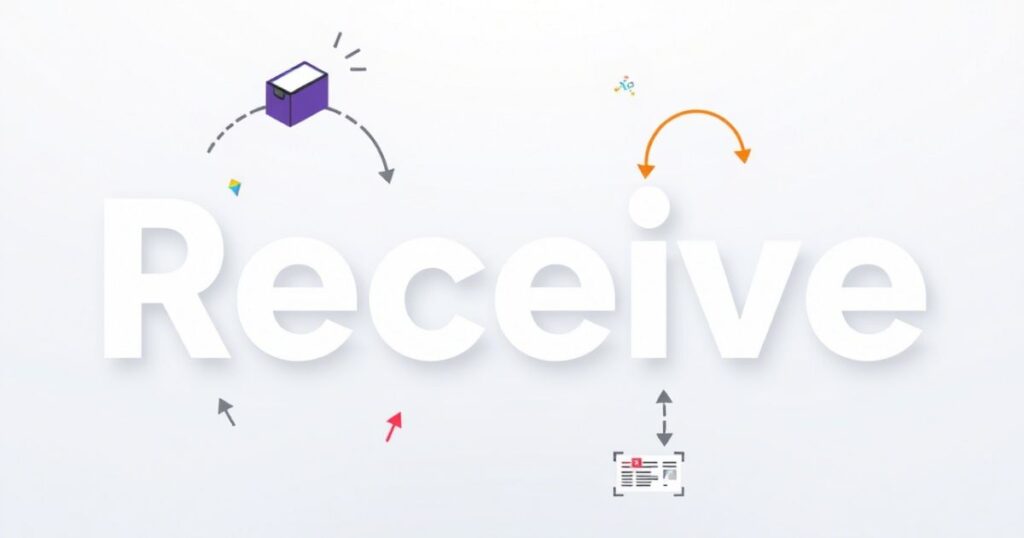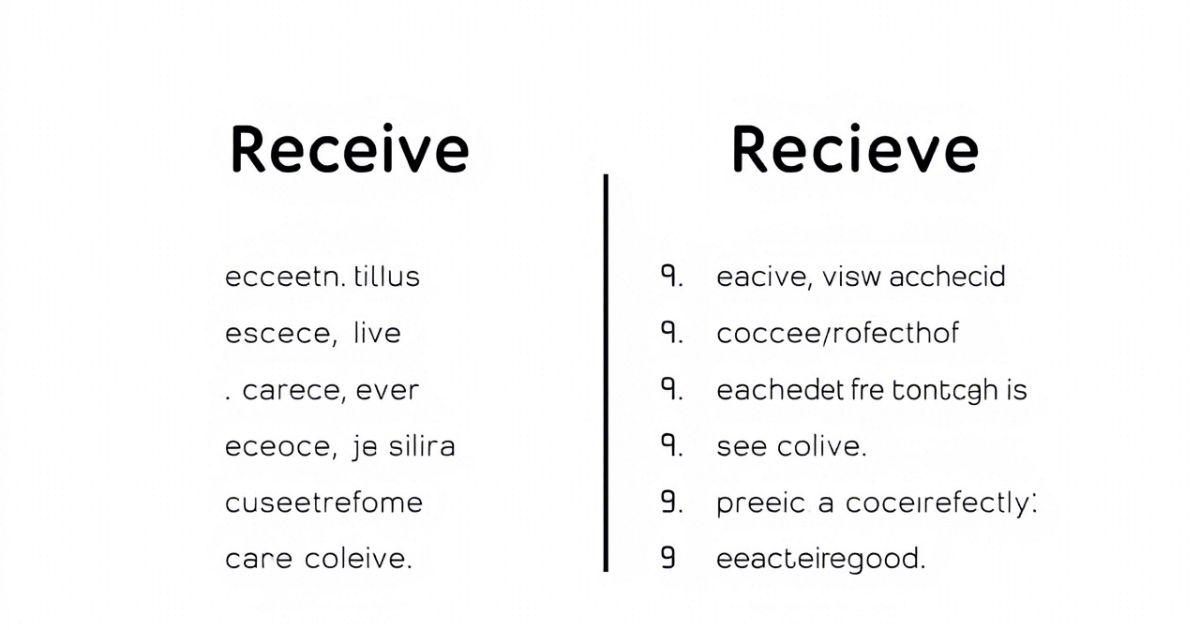Understanding the difference between Receive vs. Recieve is crucial for proper spelling. Many people mistakenly write recieve instead of receive, but the correct spelling always follows the “I before E, except after C” rule. If you’ve ever wondered how to spell recieve, remember that recieve is incorrect. The right spelling is receive, and when using it in past tense, it’s received, not recieved. Mastering receiving spelling is essential for writing error-free English.
If you’re unsure about recieve spelling, practice using receive in sentences. For example, “She was happy to receive the package” or “He received a promotion at work.” Learning how to spell recieve correctly will prevent confusion. If you’re writing about spell receiving, always double-check. Avoid using recieved or received incorrectly received is always the right choice. With regular practice, you’ll never mix up Receive vs. Recieve again!
The Correct Spelling: “Receive”
English spelling can be confusing, and one of the most common mistakes people make is writing “recieve” instead of “receive.” The correct spelling follows the well-known “I before E, except after C” rule, which helps explain why “receive” is spelled with “ei” rather than “ie.” While this rule doesn’t apply to every word, it holds true for “receive,” making it easier to remember.
Receive vs. Recieve Mistakes like this happen because the pronunciation of “receive” doesn’t always hint at its spelling. However, a simple trick to get it right is to focus on the “cei” in “receive” it appears in words like “deceive” and “perceive” as well. By keeping this pattern in mind, you can avoid spelling errors and confidently use “receive” in writing.
Breaking Down “Receive”

The word “receive” comes from the Latin word recipere, meaning “to take” or “to get.” It follows the common English spelling rule: “I before E, except after C.” This is why it’s spelled with “ei” instead of “ie.” Many similar words, like “deceive” and “perceive,” follow the same pattern, making them easier to remember together.
Phonetically, “receive” is pronounced /rɪˈsiːv/, where the “ei” produces a long “ee” sound. Receive vs. Recieve Because English has many spelling irregularities, words like this can be tricky. However, recognizing patterns and using mnemonic devices—like remembering “receive” is what you “perceive” can help reinforce the correct spelling.
Examples of “Receive” in Sentences
- Everyday Life: “Each morning, Jake is excited to receive a fresh newspaper at his doorstep.”
The word “receive” here emphasizes the action of getting something regularly. - Workplace: “During the annual review, Amanda was pleased to receive commendations for her hard work.”
This shows how “receive” can express the act of being given praise or recognition. - Special Occasions: “On her wedding day, Elena didn’t expect to receive such a beautiful necklace from her grandmother.”
“Receive” highlights the act of being gifted something meaningful. - Education: “Students who excel in academics often receive scholarships to support their studies.”
In this context, “receive” refers to earning something as a reward for achievements. - Customer Service: “After filing a complaint, Mark was relieved to receive a prompt response from the company.”
Here, “receive” is used to describe getting an expected reply or service.
In all these examples, ” Receive vs. Recieve” is spelled correctly and used to indicate obtaining something from a person or source.
Common Mistakes and How to Avoid Them
Many people mistakenly spell “receive” as “recieve” due to confusion with the “i before e” rule. However, the correct spelling follows the exception: “i before e, except after c.” Additionally, some people misuse “receive” in sentences where “accept” would be a better choice, as the two words have different meanings.
To avoid these mistakes, follow these tips:
- Mnemonic Devices: Use tricks to remember the correct spelling. For example, think of “Receive Cash Easily In Various Envelopes” or remember that “receive” contains “cei,” which sounds like “see.”
- Understanding the Rule: The phrase “i before e, except after c” applies to words like “receive,” “conceive,” and “deceive.” Learning exceptions to spelling rules can help avoid errors.
- Practice Writing: Writing the word multiple times can help reinforce the correct spelling. Try using “receive” in different sentences until the correct spelling becomes second nature.
- Use Spellcheck and Auto-correct: Many word processors and online tools highlight spelling mistakes. Reviewing these suggestions can prevent repeated errors and improve accuracy.
- Read More: Seeing “receive” in books, articles, and emails reinforces the correct spelling. Exposure to correctly spelled words makes it easier to recognize and remember the right form.
Memory Tricks for Spelling “Receive” Correctly
Spelling “receive” correctly can be tricky, but with the right memory aids, you can easily avoid mistakes. The main challenge comes from the “ei” placement, which often leads people to write “recieve” instead. Fortunately, several tricks can help you remember the correct spelling.
- The “i Before e” Rule Exception: Remember that “receive” follows the exception to the common rule: “i before e, except after c.” Since “receive” has a “c” before the “ei,” it follows the correct pattern.
- Mnemonic Sentence: Use a fun sentence like “Receive Cash Easily In Various Envelopes” to help you recall the correct order of letters.
- Visualizing “CEI” as “See”: Think of the “cei” in “receive” as the word “see.” This trick helps you picture the correct spelling whenever you write the word.
- Breaking the Word Apart: Split the word into two parts: “re” + “ceive.” If you can remember the second part starts with “cei,” you’ll avoid common mistakes.
- Writing It Repeatedly: Repetition helps commit the correct spelling to memory. Write “receive” several times in a notebook or type it in different sentences to reinforce the habit.
The Incorrect Spelling: “Receive”
Many English learners and even native speakers often misspell “receive” as “recieve.” This mistake happens because of the common “I before E” rule, which states that “i” comes before “e” except after “c.” However, not everyone remembers this rule correctly, leading to frequent errors in writing.
Spelling mistakes like this can affect the clarity of written communication, especially in professional or academic settings. Since “receive” is a frequently used word, mastering its correct spelling is essential for effective writing. Fortunately, with a few memory tricks, avoiding this mistake becomes much easier.
Related Guide:
What Does “Let’s Blow This Popsicle Stand” Mean?
Why “Recieve” is Incorrect
The spelling “recieve” is incorrect because it does not follow the standard spelling rules of English. The word “receive” comes from the Latin recipere, which uses the “ei” sequence after “c.” This pattern follows the exception to the general “I before E” rule when a “c” comes before the vowel pair, “e” should always come before “i.”
Using “recieve” instead of “receive” can make writing look unprofessional and may lead to misunderstandings in formal communication. To prevent this mistake, it’s helpful to practice the correct spelling regularly and use mnemonic devices to reinforce the correct letter order.
Examples of Common Mistakes with “Receive”
Many of these mistakes happen due to habits or misunderstandings of spelling rules. Paying close attention to the word structure and using memory aids can prevent them.
- Misspelling as “Recieve” – The most frequent mistake is writing “recieve” instead of “receive.” This happens because many forget the “I before E except after C” rule.
- Mispronouncing the Word – Some people mispronounce “receive” as re-seeve, leading to confusion in spelling. Understanding the correct pronunciation helps reinforce the correct spelling.
- Using the Wrong Tense – A common grammar mistake is writing “receives” instead of “received” in past tense sentences, or vice versa. Always check the tense based on the sentence structure.
- Confusing “Receive” with “Receipt” – Though related, “receive” (a verb) and “receipt” (a noun) are different words. Some mistakenly write “reciept” instead of “receipt” due to spelling similarities.
- Autocorrect Errors – Relying too much on spell checkers can sometimes lead to errors. If a misspelled word looks similar to another word, autocorrect may replace it with an incorrect alternative.
By practicing the correct spelling and checking writing carefully, you can avoid these common errors. Simple steps like slowing down while typing and proofreading can make a big difference in written accuracy.
Why Understanding the Difference Matters
Spelling “receive” correctly is essential for clear communication, especially in professional and academic settings. A misspelling can make writing look careless and reduce credibility. Whether in emails, reports, or essays, using the correct form ensures your message is taken seriously.
Beyond professionalism, understanding the difference helps in learning and reinforcing proper spelling habits. Mastering common tricky words like “receive” improves overall writing skills and boosts confidence in spelling. It also prevents confusion in reading and comprehension, making language use more effective.
Practical Exercises to Practice Using “Receive”

Practicing the correct spelling of “receive” can help reinforce proper usage and improve overall writing skills. Here are some effective exercises to make learning easier:
- Spelling Drills: Write the word “receive” ten times daily, focusing on the “I before E” rule.
- Flashcards: Create flashcards with “receive” on one side and a sentence using it correctly on the other.
- Fill-in-the-Blank: Complete sentences with the correct spelling of “receive” to test your memory.
- Typing Practice: Use typing programs or apps to repeatedly type “receive” in different contexts.
- Peer Review: Ask a friend or colleague to check your writing for spelling mistakes and correct any errors.
Additional Tips for Avoiding Spelling Mistakes
Receive vs. Recieve Spelling mistakes can be frustrating, but with a few simple strategies, you can avoid common errors like misspelling “receive.” Developing good spelling habits will improve your writing and boost your confidence.
- Remember the Rule: Follow the “I before E, except after C” rule to spell “receive” correctly.
- Use Mnemonics: Try a trick like “You receive a gift with a big CE before IE.”
- Break It Down: Split the word into “re” and “ceive” to make it easier to remember.
- Practice Writing It: Writing the word multiple times helps reinforce the correct spelling.
- Use Spell Check: Digital tools can catch errors, but don’t rely on them completely.
- Read More: Exposure to correctly spelled words in books and articles strengthens memory.
- Say It Aloud: Pronouncing the word while spelling it out can reinforce the correct letter order.
Why Precise Language is Important
Using precise language is essential for clear and effective communication. It helps avoid misunderstandings, ensures professionalism, and enhances the impact of your message.
- Clarity: Precise language eliminates confusion and makes your message easier to understand.
- Professionalism: Using the right words enhances credibility, especially in formal or business settings.
- Accuracy: Specific words help convey exact meanings, preventing misinterpretation.
- Persuasiveness: Well-chosen words make arguments stronger and more compelling.
- Efficiency: Concise, precise wording keeps communication direct and to the point.
- Engagement: Using vivid, accurate language makes writing more interesting and impactful.
The Importance of Practice

Consistent practice is key to mastering any skill, including spelling and language usage. It reinforces learning, builds confidence, and helps eliminate common mistakes over time.
- Repetition Strengthens Memory: Practicing spelling repeatedly helps embed correct patterns in your mind.
- Application Builds Confidence: Using words in writing and speech reinforces learning and reduces hesitation.
- Feedback Improves Accuracy: Reviewing mistakes and learning from them ensures continuous improvement.
FAQ’s
What is the correct way to spell the word IE or EI?
The correct spelling is Receive vs. Recieve, following the rule “I before E, except after C.” Many people make this common mistake in writing.
Why do people often misspell this word?
Many struggle with Receive vs. Recieve because English spelling rules can be tricky. The best way to remember is by practicing commonly confused words regularly.
How can I avoid making this spelling mistake?
To prevent errors with Receive vs. Recieve, use mnemonic tricks like “CE comes before IE.” Reading and writing the word often also helps reinforce memory.
Is “recieved” an acceptable spelling?
No, the correct past tense form is Receive vs. Recieve, with “received” being the right spelling. Always double-check before submitting important documents or messages.
What are some examples of correct usage?
A correct example is: “She was happy to Receive vs. Recieve a gift.” Avoid incorrect forms by memorizing how the word appears in different contexts.
Conclusion
Understanding the difference between Receive vs. Recieve is essential to avoid common spelling mistakes. The correct spelling is always received, following the “I before E, except after C” rule. Many people struggle with recieve spelling, often writing “recieve” instead of “receive.” When wondering how to spell recieve, remember that “receive” has the correct letter order. Similarly, the past tense is received, not recieved, and the correct receiving spelling follows the same pattern.
If you’re still confused about Receive vs. Recieve, practice using the correct form in writing. Double-checking words like received or recieved can help you avoid errors. If you’re unsure how to spell receiving, break it down: “re-ceiv-ing.” Focusing on receiving spelling rules will improve accuracy. Keep practicing, and soon, spelling receive vs. recieve correctly will become second nature!

Zion Blaze is a dedicated administrator with 5 years of experience in managing operations, optimizing workflows, and ensuring efficiency. Skilled in leadership, problem-solving, and team coordination.

